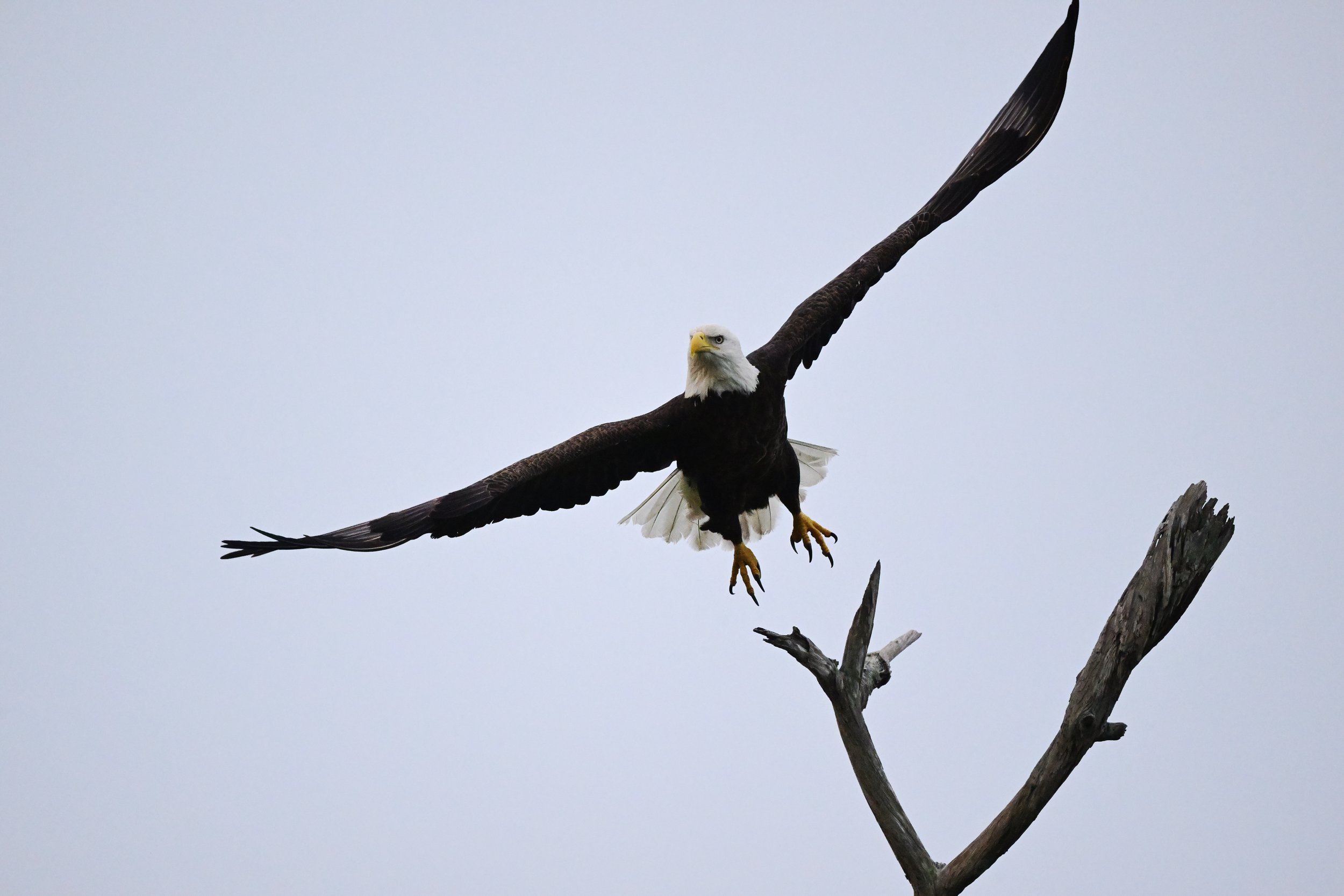 Image 1 of 1
Image 1 of 1


8x10 photo of an American bald eagle printed on professional metallic paper
The American bald eagle (Haliaeetus leucocephalus) is a bird of prey found primarily in North America. It is the national bird and symbol of the United States, recognized for its striking appearance and impressive wingspan.
Physical Characteristics:
Size: Adult bald eagles are large birds, typically measuring about 28 to 40 inches (70 to 102 cm) in length, with wingspans ranging from 5.5 to 7.5 feet (1.7 to 2.3 meters).
Plumage: They have a distinct white head and tail, which contrasts with their dark brown body and wings. Their beak is large and yellow, as are their feet.
Juveniles: Young bald eagles are mostly brown with mottled white spots and do not develop the characteristic white head and tail until they reach maturity at around 4 to 5 years of age.
Habitat:
Bald eagles are typically found near large bodies of open water with abundant food supply and old-growth trees for nesting. Their range encompasses much of North America, from Alaska and Canada down to northern Mexico.
Diet:
Their diet primarily consists of fish, which they often catch by swooping down and plucking them from the water. They are opportunistic feeders and will also scavenge carrion or hunt small mammals and birds when fish is scarce.
Behavior and Reproduction:
Nesting: Bald eagles are known for their impressive nests, which they often build in tall trees or on cliffs. These nests can be reused and expanded year after year, leading to some of the largest nests of any bird species.
Mating: They are monogamous, typically mating for life. During the breeding season, they perform aerial displays and elaborate courtship rituals.
Eggs: The female typically lays one to three eggs per breeding season, and both parents share incubating and feeding duties.
Conservation:
At one point, the American bald eagle was listed as endangered due to habitat destruction, hunting, and the effects of pesticides, particularly DDT. However, conservation efforts, including legal protection and habitat restoration, have led to a remarkable recovery in their populations. In 2007, the bald eagle was removed from the U.S. federal government's list of endangered species.
Symbolism:
The bald eagle is a powerful symbol of freedom and strength in the United States. It appears on the Great Seal of the United States and is often used in various emblems and insignia related to the government.
Overall, the American bald eagle is not only an important part of American wildlife but also a symbol of national pride and resilience.
The American bald eagle (Haliaeetus leucocephalus) is a bird of prey found primarily in North America. It is the national bird and symbol of the United States, recognized for its striking appearance and impressive wingspan.
Physical Characteristics:
Size: Adult bald eagles are large birds, typically measuring about 28 to 40 inches (70 to 102 cm) in length, with wingspans ranging from 5.5 to 7.5 feet (1.7 to 2.3 meters).
Plumage: They have a distinct white head and tail, which contrasts with their dark brown body and wings. Their beak is large and yellow, as are their feet.
Juveniles: Young bald eagles are mostly brown with mottled white spots and do not develop the characteristic white head and tail until they reach maturity at around 4 to 5 years of age.
Habitat:
Bald eagles are typically found near large bodies of open water with abundant food supply and old-growth trees for nesting. Their range encompasses much of North America, from Alaska and Canada down to northern Mexico.
Diet:
Their diet primarily consists of fish, which they often catch by swooping down and plucking them from the water. They are opportunistic feeders and will also scavenge carrion or hunt small mammals and birds when fish is scarce.
Behavior and Reproduction:
Nesting: Bald eagles are known for their impressive nests, which they often build in tall trees or on cliffs. These nests can be reused and expanded year after year, leading to some of the largest nests of any bird species.
Mating: They are monogamous, typically mating for life. During the breeding season, they perform aerial displays and elaborate courtship rituals.
Eggs: The female typically lays one to three eggs per breeding season, and both parents share incubating and feeding duties.
Conservation:
At one point, the American bald eagle was listed as endangered due to habitat destruction, hunting, and the effects of pesticides, particularly DDT. However, conservation efforts, including legal protection and habitat restoration, have led to a remarkable recovery in their populations. In 2007, the bald eagle was removed from the U.S. federal government's list of endangered species.
Symbolism:
The bald eagle is a powerful symbol of freedom and strength in the United States. It appears on the Great Seal of the United States and is often used in various emblems and insignia related to the government.
Overall, the American bald eagle is not only an important part of American wildlife but also a symbol of national pride and resilience.































